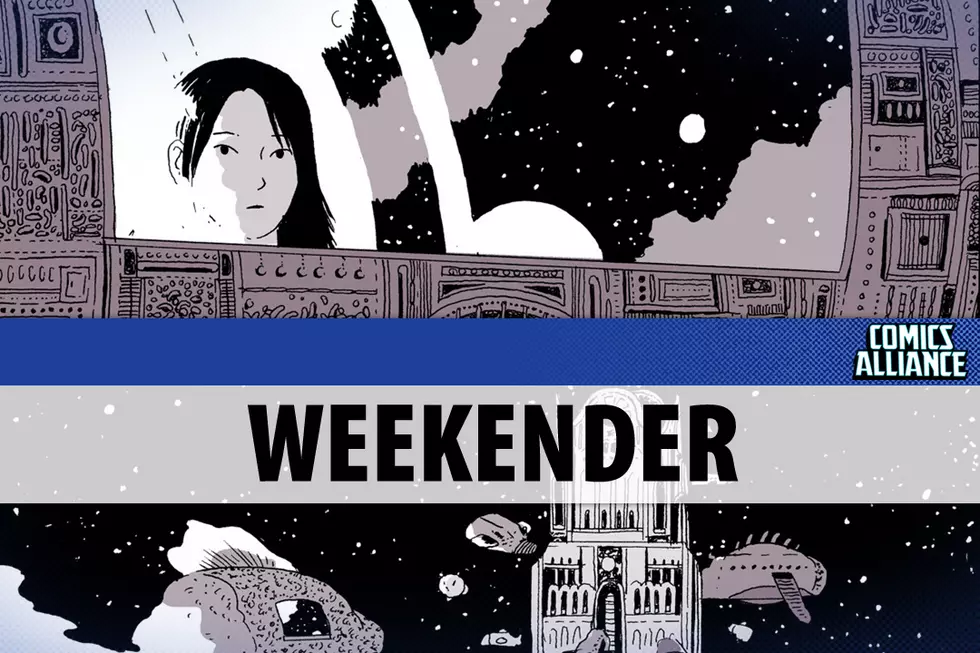![Weathercraft by Jim Woodring: A Long Overdue Trip [Review]](http://townsquare.media/site/622/files/2010/06/weathercraft-cover.jpg?w=980&q=75)
Weathercraft by Jim Woodring: A Long Overdue Trip [Review]

"Weathercraft" is my first Jim Woodring book, which, if you know me and my indie inclinations, is probably shocking. Woodring is such a big name in alt-cartooning or indie comics or lit pics or whatever, that even I can't believe I've never read him before now, especially since it's been my M.O. since about 8 years-old to reach for the weirdest looking thing on the shelf as often as possible.
I can chalk it up to laziness, sure, but I think I also suffered a bad case of false pre-familiarity. I'd read so many exaltations of Woodring's work, so many attempts to boil down the appeal in a paragraph or a review, that I was on some level convinced that I didn't need to read Woodring to "get" Woodring: lavish, rounded art recalling both '40s animation and '60s psychedelia, in which cartoon characters are bashed about with strange and terrifying violence. I always knew (or was at least pretty sure) that I'd love Woodring's stuff once I got around to digging into it, but it never seemed pressing. I knew what I was going to find.
Boy, was I an idiot.

Jim Woodring's work (of which "Weathercraft" is the latest, freshly released by Fantagraphics) is all of those things I described above, but even as a description of surface qualities, "a trippy, gory Termite Terrace" doesn't even come close. "Weathercraft" is at once far wilder and more subtle than I could have imagined. The imagery and the surroundings are more hallucinatory, the mixture of cartoon-cute and skittering, undulating grotesquerie more effectively creepy, and the characterizations and themes more layered and nuanced than any version of this book that played out in my head.

For one thing, I had no idea, nor would I have ever guessed, that Woodring's flagship character, Frank, a sort of chipmunkish guy cut from the same archetypal cartoon protagonist cloth of black fur and white gloves as Bosko, Mickey Mouse, Felix the Cat, etc., was such a solipsistic little sociopath. He spends the entire book pursuing idle luxury while unspeakable horrors go on around him; his first reaction to powerful evil is to bow down before it, and at one point he spends several pages just running around aiming a rifle at anything that moves.
It would be a mistake to read too firm a meaning into particular imagery in a book as open and dreamlike as this one, and there are parts of the work that are simply inscrutable, but there are also unavoidable resonant moments. One such is Frank, picnicking with abandon on a grassy knoll, looking on with mild but ambivalent curiosity at a screaming prisoner at the barred window of a torture camp that Frank either didn't know about or didn't care about or didn't care to know about. Torture going on under the nose of an ambivalent, luxury obsessed citizenry? Sounds pretty far-fetched to me. I'm not sure where Woodring would ever conceive of such a notion.

The torture camp features heavily in the plot of the book, which is chiefly concerned with the torment, elevation, and eventual degradation of regular Woodring character Manhog, a humanoid pig (or a porcine human?) who walks on all fours and is generally motivated by the most basic stimuli: fear, hunger, and cold. The dust jacket and a basic internet search informs me that the torture and degradation of Manhog is a regular occurrence in Woodring's work, but even a newbie such as myself can tell that "Weathercraft" is different.
 In "Weathercraft," Manhog's tribulations lead him to make an evolutionary leap. He walks on two legs, he ponders the absurdity of the universe, and he reacts to adversity with courage and action. It doesn't last, of course, but it's tantalizingly unclear what exactly drags Manhog back down to hog level. Did he make a wrong step? Is his downfall preventable? Is it something inescapable in his nature, or is it the work of the two witch-creatures that seem to be guiding the proceedings through the titular magical practice? What are those things anyway? No answers are given, but then, answers are rarely ever the point, right?
In "Weathercraft," Manhog's tribulations lead him to make an evolutionary leap. He walks on two legs, he ponders the absurdity of the universe, and he reacts to adversity with courage and action. It doesn't last, of course, but it's tantalizingly unclear what exactly drags Manhog back down to hog level. Did he make a wrong step? Is his downfall preventable? Is it something inescapable in his nature, or is it the work of the two witch-creatures that seem to be guiding the proceedings through the titular magical practice? What are those things anyway? No answers are given, but then, answers are rarely ever the point, right?
Weathercraft paints small moments of beauty and mystery on a huge canvas of twisted wonder. If you've never ventured into the deranged world of Woodring, take it from a belated first-timer that this book is as good a starting place as any, and don't you dare waste as much time as I did before taking the plunge.

More From ComicsAlliance








![Fantagraphics Collects ‘Jim,’ A Jumble Of The Mind-Bending And Mundane By Jim Woodring [Preview]](http://townsquare.media/site/622/files/2014/06/JimCover.png?w=980&q=75)
